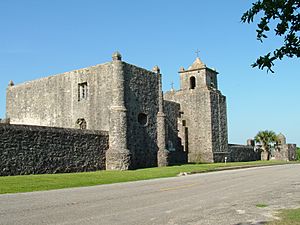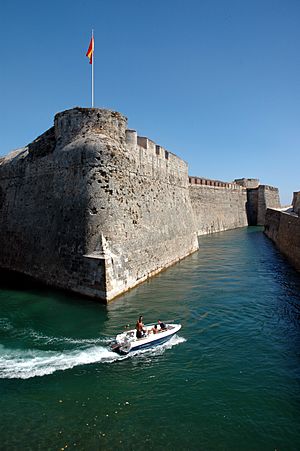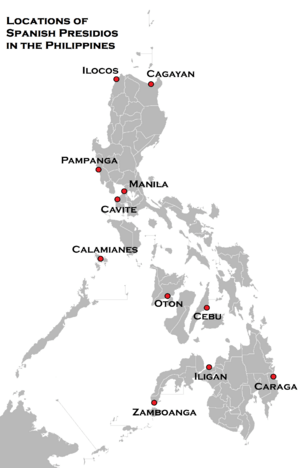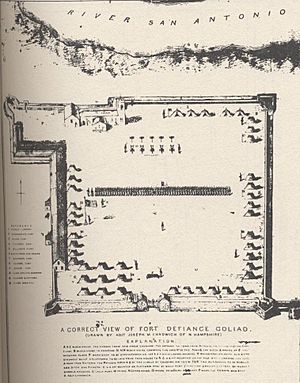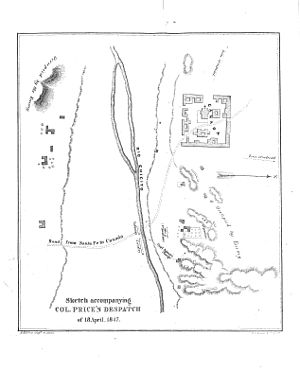Presidio facts for kids
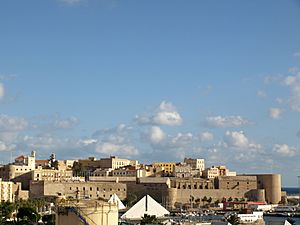
A presidio (say "pre-SEE-dee-oh") was a special kind of fortified base or fort built by the Spanish. The word "presidio" comes from a Spanish word meaning "jail" or "fortification." It also comes from the Latin word praesidium, which means "protection" or "defense."
These forts were built in areas that Spain controlled or wanted to protect. They were like strongholds that helped the Spanish keep their power and defend their lands.
In places like the Mediterranean and the Philippines, presidios were Christian outposts. They helped defend against attacks from Islamic groups. In the Americas, these forts protected against pirates and other European colonists who were rivals of Spain. They also helped defend against resistance from Native Americans.
The presidios in the Spanish-controlled Philippines were important places. Here, a martial art called Arnis de Mano was developed. This fighting style mixed Filipino, Latin-American, and Spanish techniques.
Later, in western North America, after Mexico became independent from Spain, Mexicans used these same forts. They also built new ones in frontier areas. Examples include the Presidio de Sonoma in Sonoma, California, and the Presidio de Calabasas in Arizona.
Near many presidios in western North America, there was a special ranch called a rancho del rey, or "king's ranch." This land provided food and a place for the horses and other animals used by the soldiers. In Mexico, this was called a "rancho nacional." Only Spanish military and soldiers were allowed inside presidios.
Contents
Presidios in North Africa
After the Granada War, Spain finished its Reconquista (reconquest) of Spain. The Spanish rulers then decided to expand their fight across the Strait of Gibraltar into North Africa. This was similar to what the Portuguese had done earlier when they captured Ceuta in 1415.
Spanish military outposts were set up along the North African coast. These forts were like earlier efforts by other European kingdoms. For example, the Kingdom of Sicily had built forts in the 12th century. The Kingdom of France also had forts during the Eighth Crusade in 1270.
Between 1580 and 1640, Spain and Portugal were united under one ruler. During this time, Spain gained Ceuta and other Portuguese outposts on the Atlantic Coast. These included Tangier, Mazagão/El Jadida, and Casablanca. However, after this union ended, Spain only kept Ceuta, as agreed in the Treaty of Lisbon (1668).
Here are some of the Spanish presidios in North Africa, listed from west to east:
- Mehdya, Morocco (also called La Mamora or San Miguel de Ultramar), 1614-1681
- Larache, 1610-1689
- Ceuta, acquired from Portugal in 1668
- Peñón de Vélez de la Gomera, 1508-1522 and since 1564
- Alhucemas Islands, since 1559
- Cazaza, 1505-1533
- Melilla, since 1497
- Honaine, briefly in 1534
- Mers El Kébir (Mazalquivir), 1505-1708 and 1732-1792
- Oran, 1509-1708 and 1732-1792
- Algiers (Argel), 1510-1516; Peñón islet until 1529
- Béjaïa (Bugia), 1510-1555
- Annaba (Bona), 1535-1540
- Bizerte (Bizerta), 1535-1574
- La Goulette (La Goleta), 1535-1574
- Tunis (Túnez), 1573-1574 (was a protectorate from 1535 to 1569)
- Sousse (Susa), 1537-1574
- Monastir, 1550-1554
- Mahdia (Mahdía), 1550-1553
- Djerba (Yerba), 1521-1523 and 1551-1560
- Tripoli (Trípoli), 1510-1530 then given to the Knights Hospitaller who held it until 1551
Presidios in Italy
Several forts that used to belong to the Republic of Siena became Spanish property. This happened after Siena's government ended. Spain's King Philip II of Spain and Cosimo I de' Medici, Grand Duke of Tuscany made a treaty on July 3, 1557. These forts became known as the Estado de los Presidios (State of the Presidios).
Spain held these forts until the War of the Spanish Succession. After that war, they became Austrian property and were managed from Naples.
Some of these presidios included:
Presidios in the Philippines
Luzon Island
- The Presidio de Santiago, built in 1593 in Intramuros, Manila.
- The Presidio de San Felipe (Cavite), built in 1609 in San Roque, Cavite.
Visayas Islands
- Presidio de Lawis in Madridejos, Cebu. Its current structure is the oldest in the country, built around 1628-1630.
- The Presidio (Fort) de San Pedro (Iloilo), built in 1616 in Iloilo City.
- The Presidio de San Pedro (Cebu), built in 1630 in Cebu.
Mindanao Island
- The Presidio de Nuestra Señora del Pilar de Zaragoza, built in 1635 in Zamboanga.
Presidios in Mexico
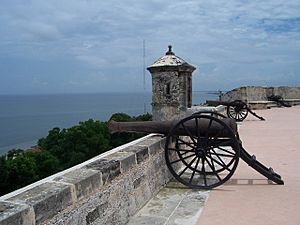
Presidios were built in the northern parts of Mexico, which were frontier regions. Their purpose was to control and keep rebellious Native American tribes in check. Sometimes, captured Native American warriors were held as prisoners and enslaved at these presidios.
Sonora Region
- The Presidio de San Felipe y Santiago de Janos, built in 1685 in Janos, Sonora.
- The Presidio del Pitic, built in 1726 in Hermosillo, Sonora.
- The Presidio Santa Gertrudis del Altar, built in 1755 in Altar, Sonora.
- The Presidio de Santa Rosa de Corodéguachi, built in 1692 near the Sonora/Arizona border. It later moved to Fronteras, Sonora.
- The Presidio de San Bernardino, built in 1776 near today's Douglas.
Durango Region
- The Presidio de Santa Catalina de Tepehuanes (1620 - 1690s?), in Santa Catarina de Tepehuanes.
- The Presidio del Pasaje (1685), on Rio Nazas northwest of Cuencamé.
- The Presidio de San Pedro del Gallo (1690s), in San Pedro del Gallo.
- The Presidio de Santiago de Mapimí (1715), in Mapimí.
- The Presidio de San Miguel de Cerrogordo (1648-1767) in Villa Hidalgo.
Chihuahua Region
- The Presidio de El Paso del Río Grande del Norte (1683 - 1773), at Ciudad Juárez, across the river from El Paso, Texas. It was later moved south in 1773 to Carrizal.
- The Presidio de San Felipe y Santiago de Janos (1691-?), in Janos.
- The Presidio de Casas Grandes (1686), which was moved to Janos in 1691.
- The Presidio de San Francisco de Conchos, built in 1685 at San Francisco de Conchos.
- The Presidio de San Bartolomé (? - 1710), located 20 km east of Parral. It was replaced by a mobile group of soldiers.
- The Presidio de Nuestra Señora de las Caldas de Guajoquilla, built in 1752 in Jiménez.
- The Presidio de San Fernando de Carrizal (1758 - ?).
Coahuila Region
- The Presidio del Santísimo Sacramento del Valle de Santa Rosa, built in 1780 in Melcho Muzquiz, Coahuila.
- The Presidio San Juan Bautista del Río Grande, built around 1703 in San Juan Bautista, which is now Guerrero, Coahuila.
- The Presidio San Antonio Bucareli de la Babia, built in 1774 in today's La Babia, Coahuila.
- The Presidio San Gregorio de Cerralvo, built in 1626 in Nuevo Leon, Mexico.
Presidios in the United States
South Carolina
- The Presidio Santa Elena, built in 1566 on Parris Island. It was destroyed by Native Americans in 1576, rebuilt in 1577, and then left empty in 1587.
Georgia
- The Presidio Guale, built in 1566, but abandoned just three months later.
- The Presidio San Pedro de Tacatacuru, built in 1569 on Cumberland Island, and abandoned in 1573.
Florida
- The Presidio San Augustin, built in 1565. This presidio grew into the city of St. Augustine. It was given to Great Britain in 1763, taken back 20 years later, and then given to the United States in 1821.
- The Presidio San Mateo, built in 1565 on the ruins of Fort Caroline. It was captured and destroyed by the French in 1568.
- The Presidio Ais, built in 1565 on the Indian River Lagoon, abandoned after only one month.
- The Presidio Santa Lucia, built in 1565 near Cape Canaveral, abandoned four months later.
- The Presidio San Antonio de Padua, built in 1566 at Calos, the main city of the Calusa people. It was abandoned in 1569.
- The Presidio Tocobaga, built in 1567 on Tampa Bay, destroyed by the Tocobagas within ten months.
- The Presidio Tequesta, built in 1567 where Miami is today, abandoned in 1568.
- The Presidio Santa Maria de Galve, built in 1696 near Fort Barrancas at today's Naval Air Station Pensacola. It was captured by the French in 1719. The Spanish then moved to Presidio Bahía San José de Nueva Asturias.
- The Presidio Bahía San José de Valladares, built in 1701 on St. Joseph Bay, captured by the French in 1718.
- The Presidio San Marcos de Apalachee, built in 1718 at the existing port of San Marcos. This grew into the town of St. Marks. It was given to Great Britain in 1763, taken back 20 years later, and then given to the United States in 1821.
- The Presidio Bahía San José de Nueva Asturias, built in 1719 on St. Joseph Point. It was abandoned when the Spanish got the Pensacola Bay area back from the French in 1722. The Spanish then moved to Presidio Isla Santa Rosa Punta de Siguenza.
- The Presidio Isla Santa Rosa Punta de Siguenza, built in 1722 on Santa Rosa Island. It was destroyed by a hurricane in 1755. The Spanish then moved to Presidio San Miguel de Panzacola.
- The Presidio San Miguel de Panzacola, built in 1755. This grew into the city of Pensacola. It was given to Great Britain in 1763, taken back 20 years later, and then given to the United States in 1821.
Louisiana
- The Presidio Nuestra Señora del Pilar de los Adaes, built in 1721 near today's Robeline.
Texas
- The Presidio Fuerte de Santa Cruz del Cibolo, built in 1734 and rebuilt in 1771 near Cestohowa, Texas in Karnes County, Texas. This is between San Antonio and Goliad.
- The Presidio San Antonio de Béxar, built in 1718 in San Antonio.
- The Presidio Nuestra Señora de Loreto, built in 1721 near Lavaca Bay, now in Goliad.
- The Presidio of San Carlos de Cerro Gordo, built in 1772 in Big Bend Country.
- The Presidio San Luis de las Amarillas San Saba, built in 1772 near today's Menard.
- The Presidio de la Junta de los Ríos Norte y Conchos, built in 1760 just southwest of today's Presidio.
New Mexico
- The Presidio Santa Cruz de la Cañada, in Santa Cruz.
Arizona
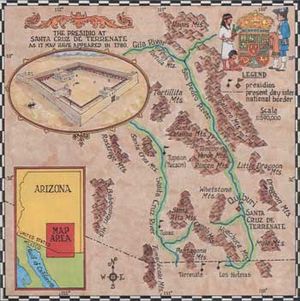
- The Presidio San Ignacio de Tubac, built in 1752 in Tubac.
- The Presidio San Augustin del Tucson, built in 1775 in Tucson.
- The Presidio Santa Cruz de Terrenate, built in 1775 near today's Tombstone.
- The Presidio de Calabasas, built in 1837 near today's Tumacacori.
California
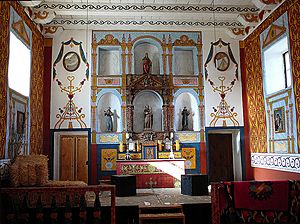

- The Presidio Real de San Carlos de Monterey, built in 1770. Its "king's ranch" became Rancho Nacional. Today, it houses the Defense Language Institute in Monterey.
- The Presidio Real de San Diego, built in 1769 in San Diego. Its "king's ranch" became Rancho de la Nación.
- The Presidio Real de San Francisco, built in 1776. It is now part of the Golden Gate National Recreation Area in San Francisco. Its "king's ranch" became Rancho Buri Buri.
- The Presidio Real de Santa Bárbara, built in 1782 in Santa Barbara. Its "king's ranch" became Rancho San Julian.
- The Presidio de Sonoma, built by Mexico in 1836 in Sonoma. Its "national ranch" became Rancho Suscol.
Presidios in Canada
Images for kids
-
Red Castle of Tripoli
-
Peñafiel Castle, a fort used by both Arabs and Spanish
-
Former Hermosillo, Sonora town hall, which was the Presidio del Pitic
See also
 In Spanish: Presidio para niños
In Spanish: Presidio para niños


